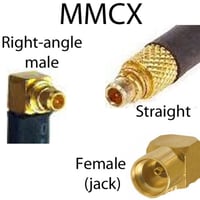N to RP-TNC and TNC
N-Type Connector to TNC and RP-TNC: Antenna Cables
The TNC connector
The Threaded Neil Concelman connector is a threaded medium-sized radio frequency connector, capable of supporting microwave frequencies. It is derived from the Bayonet Neil Concelman (BNC) connector but is mated by screw coupling.
Physical specifications of the TNC connector
- Connector body is made from brass and phosphor bronze
- 7/16 - 28 UNEF threading
- Male connector: diameter of 15 millimeters (0.59 inches), internalized threads, and phosphor bronze center pin surrounded by a Teflon insulator.
- Female connector: diameter of 9.6 millimeters (0.378 inches), externalized threads, and a center receptacle surrounded by a Teflon insulator.
Electrical specifications of the TNC connector
- Impedance: 50 or 75 Ohms,
- Maximum frequency: up to 11GHz
- VSWR: 1.3
- Working voltage: 500 volts
- Maximum radio frequency leakage: -60 dB/min (2 -3 GHz)
The RP-TNC connector
The Reverse Polarity Threaded Neil Concelman (TNC) connector is a Reverse Polarity (RP) version of the TNC connector. It was developed in the late 1990s as a connector class specifically for consumer wireless networking gear.
RP-TNC connectors are:
- Structurally and electrically identical to the standard TNC connector
- Reversed mating interfaces of the male and female TNC connector
- Male connector: carries a receptacle rather than the pin in the standard version of the connector.
- Female connector: carries the center pin rather than a receptacle in the standard TNC connector.
The electrical specifications of the 50-Ohm RP-TNC connector are identical to the standard version, making this connector suitable for sub-gigahertz and gigahertz frequencies.
Cable for TNC to N cable
TNC and RP-TNC to N connector cable uses coaxial cable of exceptional quality and performance. LMR 100 is a semi-rigid, low-loss coaxial cable with double shielding.

Physical specifications of LMR 100
- Bare copper-clad steel (BCCS) center conductor with a diameter of 0.018 inches (0.46mm)
- Solid polyethylene (PE) dielectric with a diameter of 0.06 inches (1.52mm)
- Unbonded aluminum tape outer conductor
- Tinned copper outer braiding with a diameter of 0.083 inches (2.11mm)
- Plastic outer jacket - total diameter of LMR 100 to 0.11 inches or (2.79mm)
- Bend radius of 0.25 inches (6.24mm)
Electrical specifications of LMR 100
- Nominal impedance: 50 Ohms
- Capacitance: 30.8 pF/ft (100.1pF/m)
- Inductance: 0.077uH/ft (0.25 uH/m).
- Velocity of propagation (Vp): 66%.
- Shielding effectiveness: more than 90 decibels
- Maximum voltage: 500 volts.
Type N connector
The size and ruggedness of an N-connector make it useful for outdoor applications, so radio devices that are primarily used or installed outdoors use this connector. Here are the Type N connector specifications:
Physical specifications of the N connector
- Threaded medium-size connector
- 5/8 - 24 pitched UNEF threading
- Mates by screw coupling; rated for 500+ mating cycles
- Material: nickel-plated brass or stainless steel
- Male N connector: diameter of 0.800 inches (20.3 millimeters) with internalized threads and hex nut
- Female N connector: diameter of 0.620 inches (15.7 millimeters)with externalized threads
- O-ring seal achieves an IP 67 rating, making the connection dust and moisture-free
- Standard N connectors do not have a dielectric
Electrical specifications of the N connector
- Nominal impedance: 50 ohms
- Maximum frequency: up to 11 GHz
- Peak voltage rating: 1500 volts
- Dielectric withstanding voltage: up to 2500 volts.
- VSWR of 1.3.
- Contact resistance: 1 milliohm
- Insertion loss: 0.15 dB.
- Radio frequency leakage: -90 decibels at 3GHz.
Applications of TNC/ RP-TNC to N connector cables
TNC and RP-TNC adapters are utilized in a range of wireless and telecommunications applications where a robust, stable connection is critical to performance. Because of their ruggedness, and excellent power handling, they are also used in industrial, defense, aviation and space market settings. In combination with the N connector, they are suitable for a variety of outdoor applications or uses that require competent power handling.







